Types and Evolution of the Miocene Reefs Based on Seismic Data in the Beikang Basin, South China Sea
Abstract
1. Introduction
2. Regional Geological Background
3. Data and Methods
4. Results
4.1. Types of the Reefs
4.1.1. Point Reefs
4.1.2. Platform Edge Reefs
4.1.3. Massive Reefs
4.1.4. Layered Reefs
4.1.5. Tower Reefs
4.1.6. Atolls
4.2. Spatiotemporal Distribution of the Reefs
5. Discussion
5.1. Controlling Factors
5.1.1. Tectonics
5.1.2. Sea Level Change
5.1.3. Terrigenous Debris Input
5.2. Evolution Stage
5.2.1. Initial Stage
5.2.2. Flourishing Stage
5.2.3. Recession Stage
5.2.4. Submerged Stage
6. Conclusions
- (1)
- Six types of reefs were identified in the Beikang Basin: the point reefs, the platform marginal reefs, the massive reefs, the layered reefs, the tower reefs, and the atolls. The platform marginal reefs are the most representative, with some reefs exhibiting a large scale and lateral spread exceeding 10 km. These reefs are extensively distributed on both the Central Uplift and Eastern Uplift of the Beikang Basin as well as on their surrounding slopes.
- (2)
- The development and evolution of reefs in the Beikang Basin can be categorized into four distinct stages: the initial development stage in the Early Miocene, the flourishing stage in the Early Middle Miocene, the recession stage in the late Middle Miocene, and the submerged stage in the Late Miocene. The landform of the Beikang Basin in the late Early Miocene, resulting from the Nansha Movement, provided favorable conditions for the initial development of reefs. Subsequently, rapid basement subsidence during the late period played a decisive role in shaping different stages of reef development since the Late Miocene.
- (3)
- The spatial distribution of reefs in the Beikang Basin is primarily influenced by tectonic and sea level fluctuations, intricately intertwined with the historical expansion and collision evolution of the South China Sea. Since the Early Miocene, the Beikang Basin has experienced a shallowing of the water depth as a result of block collision, leading to the initiation of platform development. During the Middle Miocene, the South China Sea expansion halted, leading to a stable tectonic environment and the flourishing of the platform. However, following the Late Miocene period, platform development experienced a decline due to rapid sedimentation and the influence of marginal clastic injection until eventual submergence.
Author Contributions
Funding
Institutional Review Board Statement
Informed Consent Statement
Data Availability Statement
Acknowledgments
Conflicts of Interest
References
- Riding, R. Structure and composition of organic reefs and carbonate mud mounds: Concepts and categories. Earth Sci. Rev. 2000, 58, 163–231. [Google Scholar] [CrossRef]
- Belopolsky, A.; Droxler, A. Imaging Tertiary carbonate system-the Maldives, Indian Ocean: Insights into carbonate sequence interpretation. Lead. Edge 2003, 22, 646–652. [Google Scholar] [CrossRef]
- Wilson, M.J. Global and regional influences on equatorial shallow-marine carbonates during the Cenozoic. Palaeogeogr. Palaeoclimatol. Palaeoecol. 2008, 265, 262–274. [Google Scholar] [CrossRef]
- Betzler, C.; Hübscher, C.; Lindhorst, S.; Reijmer, J.; Römer, M.; Droxler, A.; Füstenau, J.; Lümann, T. Monsoon-induced partial carbonate platform drowning (Maldives, Indian Ocean). Geology 2009, 37, 867–870. [Google Scholar] [CrossRef]
- Zampetti, V.; Schlager, W.; Konijnenburg, V.; Everts, A.J. Architecture and growth history of a Miocene carbonate platform from 3D seismic reflection data: Luconia province, offshore Sarawak, Malaysia. Mar. Pet. Geol. 2004, 21, 517–534. [Google Scholar] [CrossRef]
- Zhou, G.; Zhen, R.C.; Chen, H.R.; Shi, J.N.; Wen, G.H. The types of evolution of platform-edge reefs in the Permian Changxing Formation, eastern Sichuan Basin. Geol. China 2013, 40, 1140–1149, (In Chinese with English abstract). [Google Scholar]
- Mi, L.J.; Zeng, Q.B.; Yang, H.C. Types of organic reef and exploration direction in Zhujiang Formation of Dasha Uplift. Acta Pet. Sinaca 2013, 34, 24–31, (In Chinese with English abstract). [Google Scholar]
- Wu, S.G.; Yang, Z.; Wang, D.W.; Lü, F.L.; Lüdmann, T.; Fulthorpe, C.; Wang, B. Architecture, development and geological control of the Xisha carbonate platforms, northwestern South China Sea. Mar. Geol. 2014, 350, 71–83. [Google Scholar] [CrossRef]
- Wu, F.; Xie, X.; Zhu, Y.; Coletti, G.; Betzler, C.; Cui, Y.; Bai, H.; Chen, B.; Shang, Z. Early development of carbonate platform (Xisha Islands) in the northern South China Sea. Mar. Geol. 2021, 441, 106629. [Google Scholar] [CrossRef]
- Wu, F.; Zhu, Y. Quaternary subsidence history of Xisha Islands (northern South China Sea): Evidences from the reef-bank system. Mar. Pet. Geol. 2022, 144, 105843. [Google Scholar] [CrossRef]
- Tian, J.; Wu, S.; Lv, F.; Wang, D.; Wang, B.; Zhang, X.; Ma, B. Middle Miocene mound-shaped sediment packages on the slope of the Xisha carbonate platforms, South China Sea: Combined result of gravity flow and bottom current. Deep Sea Res. Part II Top. Stud. Oceanogr. 2015, 122, 172–184. [Google Scholar] [CrossRef]
- Wang, W.Z.; Yang, Y.M.; Wen, L.; Luo, B.; Luo, W.J.; Xia, M.L.; Sun, S.N. A study of sedimentary characteristics of microbial carbonate: A case study of the Sinian Dengying Formation in Gaomo area, Sichuan Basin. Geol. China 2016, 43, 306–318, (In Chinese with English abstract). [Google Scholar]
- Tyrrell, W.; Christian, E. Exploration history of Liuhua 11-1 field, Pearl River Mouth Basin, China. AAPG Bull. 1992, 76, 1209–1223. [Google Scholar]
- Qiu, Y.; Wang, Y.M. Reefs and paleostructure and paleoenvironment and the South China Sea. Mar. Geol. Quat. Geol. 2001, 21, 65–73, (In Chinese with English abstract). [Google Scholar]
- Ding, W.W.; Li, J.B.; Dong, C.Z.; Fang, Y.X. Oligocene–Miocene carbonates in the Reed Bank area, South China Sea, and their tectono-sedimentary evolution. Mar. Geophys Res. 2015, 36, 149–165. [Google Scholar] [CrossRef]
- Zhang, G.X.; Bai, Z.L. The characteristics of structural styles and their influences on oil and gas accumulation of the Wan’an Basin in the southwestern South China Sea. Exp. Pet. Geol. 1998, 20, 210–216, (In Chinese with English abstract). [Google Scholar]
- Fournie, F.; Montaggioni, L.; Borgomano, J. Paleoenvironments and high-frequency cyclicity from Cenozoic South-East Asian shallow-water carbonates: A case study from the Oligo-Miocene buildups of Malampaya (Offshore Palawan, Philippines). Mar. Pet. Geol. 2004, 21, 1–21. [Google Scholar] [CrossRef]
- Fournier, F.; Borgomano, J.; Montaggioni, L. Development patterns and controlling factors of Tertiary carbonate buildups: Insights from high-resolution 3D seismic and well data in the Malampaya gas field (Offshore Palawan, Philippines). Sediment. Geol. 2005, 175, 189–215. [Google Scholar] [CrossRef]
- Wu, S.; Zhang, X.; Yang, Z.; Wu, T.; Gao, J.; Wang, D. Spatial and temporal evolution of Cenozoic carbonate platforms on the continental margins of the South China Sea: Response to opening of the ocean basin. Interpretation 2016, 4, SP1–SP19. [Google Scholar] [CrossRef]
- Wang, H.B.; Yao, B.C.; Liang, J.Q.; Liu, Z.H.; Wang, L.L. Tectonic characteristics and division of the Beikang Basin. Mar. Geol. Quat. Geol. 2001, 21, 49–54, (In Chinese with English abstract). [Google Scholar]
- Wang, L.L.; Wu, N.Y.; Zhou, Z.Y.; Chen, Q. History of the Cenozoic Sedimentary evolution of the Beikang Basin, southwest South China Sea. Geol. China 2002, 29, 96–102, (In Chinese with English abstract). [Google Scholar]
- Madon, M.; Ly, K.C.; Wong, R. The structure and stratigraphy of deepwater Sarawak, Malaysia: Implications for tectonic evolution. J. Asian Earth Sci. 2013, 76, 312–333. [Google Scholar] [CrossRef]
- Madon, M.; Abdul, H. Penecontemporaneous deformation in the Nyalau Formation (Oligo-Miocene), Central Sarawak. Bull. Geol. Soc. Malays. 2007, 53, 67–73. [Google Scholar] [CrossRef][Green Version]
- Ismail, C.M.Z.; Tucker, M.E. An alternative stratigraphic scheme for the Sarawak Basin. J. Asian Earth Sci. 1999, 17, 215–232. [Google Scholar]
- Hutchison, C.S. Marginal basin evolution: The southern South China Sea. Mar. Pet. Geol. 2004, 21, 1129–1148. [Google Scholar] [CrossRef]
- Jin, Q.H.; Wu, J.M.; Xie, Y.Q. The Analysis and Oil Resource of Sedimentary Basins in West of Nansha Sea Area; China University of Geosciences Press: Wuhan, China, 2001; pp. 235–238. (In Chinese) [Google Scholar]
- Hall, R. Cenozoic geological and plate tectonic evolution of SE Asia and the SW Pacific: Computer-based reconstructions, model and animations. J. Asian Earth Sci. 2002, 20, 353–431. [Google Scholar] [CrossRef]
- Li, C.F.; Li, J.B.; Ding, W.W.; Franke, D.; Yao, Y.J.; Shi, H.S.; Pang, X.; Cao, Y.; Lin, J.; Kulhanek, D.; et al. Seismic stratigraphy of the central South China Sea basin and implications for neotectonics. J. Geophys. Res. Solid Earth 2015, 120, 1377–1399. [Google Scholar] [CrossRef]
- Liu, Z.H.; Guo, L.H. Subsidence and tectonic evolution of the Beikang Basin, the South China Sea. Mar. Geol. Quat. Geol. 2003, 23, 51–57, (In Chinese with English abstract). [Google Scholar]
- Zhang, L.; Wang, L.L.; Yi, H. The Formation and evolution of Beikang Basin. China Offshore Oil Gas Geol. 2003, 17, 245–248, (In Chinese with English abstract). [Google Scholar]
- Abdul, M.M.; Wong, R.H.F. Seismic sequence stratigraphy of the Tertiary sediments, offshore Sarawak deepwater area, Malaysia. Geol. Soc. Malays. Bull. 1995, 37, 345–361. [Google Scholar]
- Haq, B.V.; Hardenbol, J.; Vail, P.R. Mesozoic and Cenozoic chronostratigraphy and cycles of sea level change. In Sea Level Changes—An Integrated Approach; Wilgus, C., Hasting, B., Posamentier, H., Van Wagoner, J., Ross, C., Kendall, C., Eds.; Special Publication; SEPM: Tulsa, OK, USA, 1988; Volume 42, pp. 71–108. [Google Scholar]
- Ma, Y.B.; Wu, S.G.; Lv, F.L.; Dong, D.D.; Sun, Q.L.; Lu, Y.T.; Gu, M.F. Seismic characteristics and development of Xisha carbonate platforms, northern South China Sea margin. J. Asian Earth Sci. 2011, 40, 770–783. [Google Scholar]
- Yang, C.P.; Yao, Y.J.; Li, X.J.; Chang, X.H. Sequence stratigraphy and sedimentary cycle of Miocene carbonate buildups in Zengmu Basin, the Southern South China Sea. Earth Sci.—J. China Univ. Geosci. 2014, 39, 91–98, (In Chinese with English abstract). [Google Scholar]
- Pomar, L. Types of carbonate platforms: A genetic approach. Basin Res. 2001, 13, 313–334. [Google Scholar] [CrossRef]
- Briais, A.; Patriat, P.; Tapponnier, P. Updated interpretation of magnetic anomalies and seafloor spreading stages in the South China Sea: Implications for the Tertiary tectonics of southeast Asia. J. Geophys. Res. 1993, 98, 6299–6328. [Google Scholar] [CrossRef]
- Eduard, K. Sea-level changes, shoreline Journeys, and the seismic stratigraphy of central Luconia, Miocene-present, offshore Sarawak, NW Borneo. Mar. Pet. Geol. 2015, 59, 35–55. [Google Scholar]
- Andrew, C. Nature and significance of the West Baram and Tinjar Lines, NW Borneo. Mar. Pet. Geol. 2014, 51, 197–209. [Google Scholar]
- Du, X.; Lu, Y.; Li, X.; Li, J. Development and controlling factors of Upper Oligocene–Lower Miocene carbonate platforms and reefs in the Liyue Basin, South China Sea. Geol. J. 2019, 54, 3272–3285. [Google Scholar] [CrossRef]
- Zhang, Y.F.; Liao, J.; Sun, Z.; Li, F.C.; Xia, B. Characteristics of Tectonic Subsidence of Nansha Area. Earth Sci.—J. China Univ. Geosci. 2011, 36, 949–955. [Google Scholar]
- Lü, C.; Yao, Y.; Gong, Y.; Wu, S.; Li, X. Deepwater canyons reworked by bottom currents: Sedimentary evolution and genetic model. J. Earth Sci. 2012, 23, 731–743. [Google Scholar] [CrossRef]
- Hall, R.; Nichols, G. Cenozoic sedimentation and tectonics in Borneo: Climatic influences on orogenesis. In Sediment Flux to Basins: Causes, Controls and Consequences; Jones, S.J., Frostick, L.E., Eds.; Special Publication; Geological Society of London: London, UK, 2002; Volume 191, pp. 5–22. [Google Scholar]
- Hamilton, W. Map of Sedimentary Basins of the Indonesian Region; Report No. I-875-B; USGS: Reston, VA, USA, 1974.
- Hutchison, C.S.; Bergman, S.C.; Swauger, D.A.; Graves, J.E. A Miocene collisional belt in north Borneo: Uplift mechanism and isostatic adjustment quantified by thermochronology. J. Geol. Soc. Lond. 2000, 157, 783–793. [Google Scholar] [CrossRef]
- Mathew, M.; Makhankova, A.; Menier, D.; Sautter, B.; Betzler, C.; Pierson, B. The emergence of Miocene reefs in South China Sea and its resilient adaptability under varying eustatic, climatic and oceanographic conditions. Nat. Sci. Rep. 2020, 10, 7141. [Google Scholar] [CrossRef] [PubMed]
- Lü, C.L.; Wu, S.G.; Yao, Y.J.; Fulthorpe, C. Development and controlling factors of Miocene carbonate platform in the Nam Con Son Basin, southwestern South China Sea, southwestern South China Sea. Mar. Pet. Geol. 2013, 45, 55–68. [Google Scholar] [CrossRef]
- Madon, M.; Redzuan, A.H. West Luconia Province. In The Petroleum Geology and Resources of Malaysia; PETRONAS: Kuala Lumpur, Malaysia, 1999; pp. 427–439. [Google Scholar]
- Xu, H.; Sun, J.; Liao, J.; Dong, G.; Liu, J.; Song, H.; Wang, Z.; Sun, Z.; Jin, Q.; Zhang, L.; et al. Bioherm petroleum reservoir types and features in main sedimentary basins of the South China Sea. J. Earth Sci. 2012, 23, 828–841. [Google Scholar] [CrossRef]
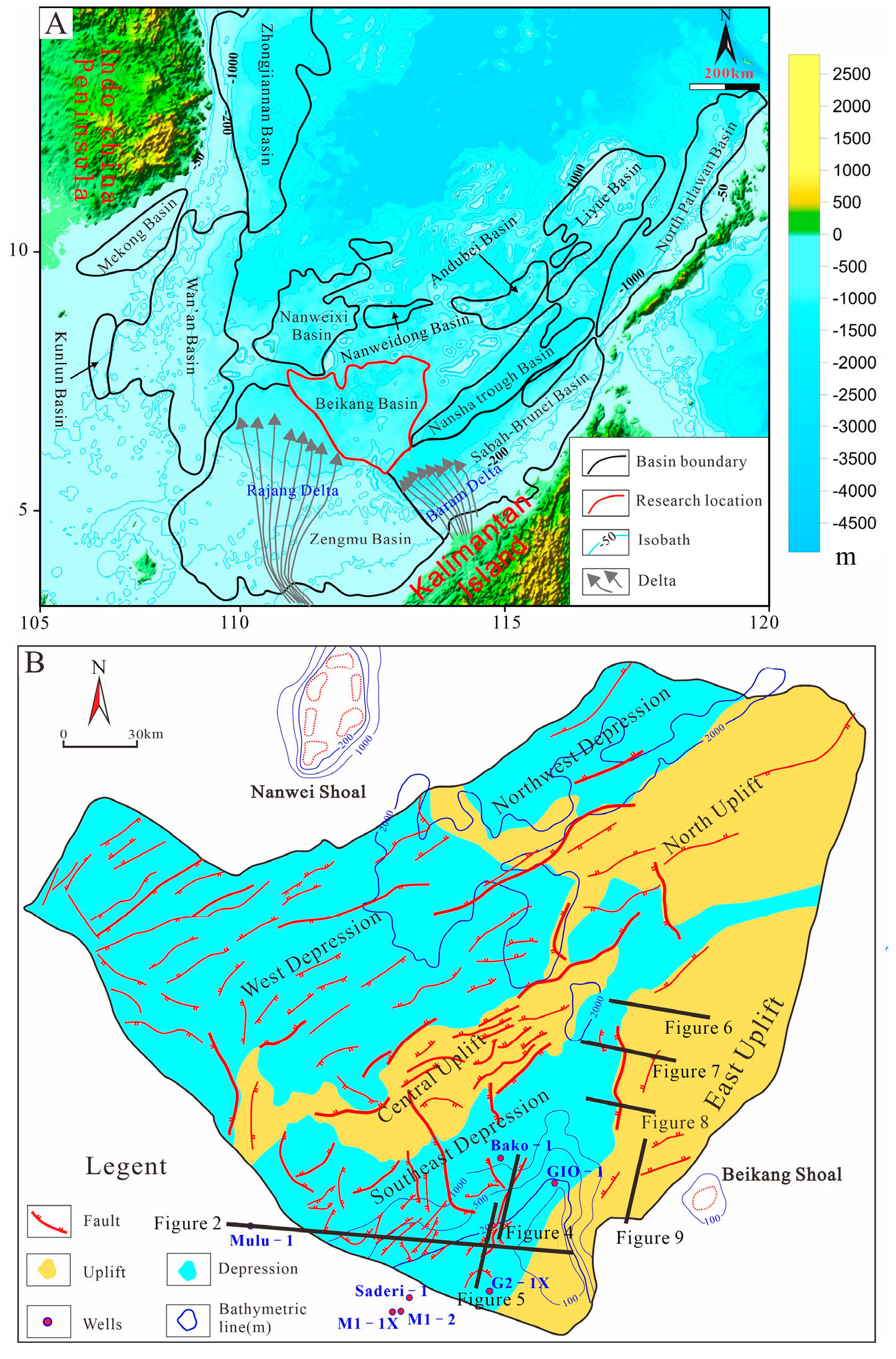
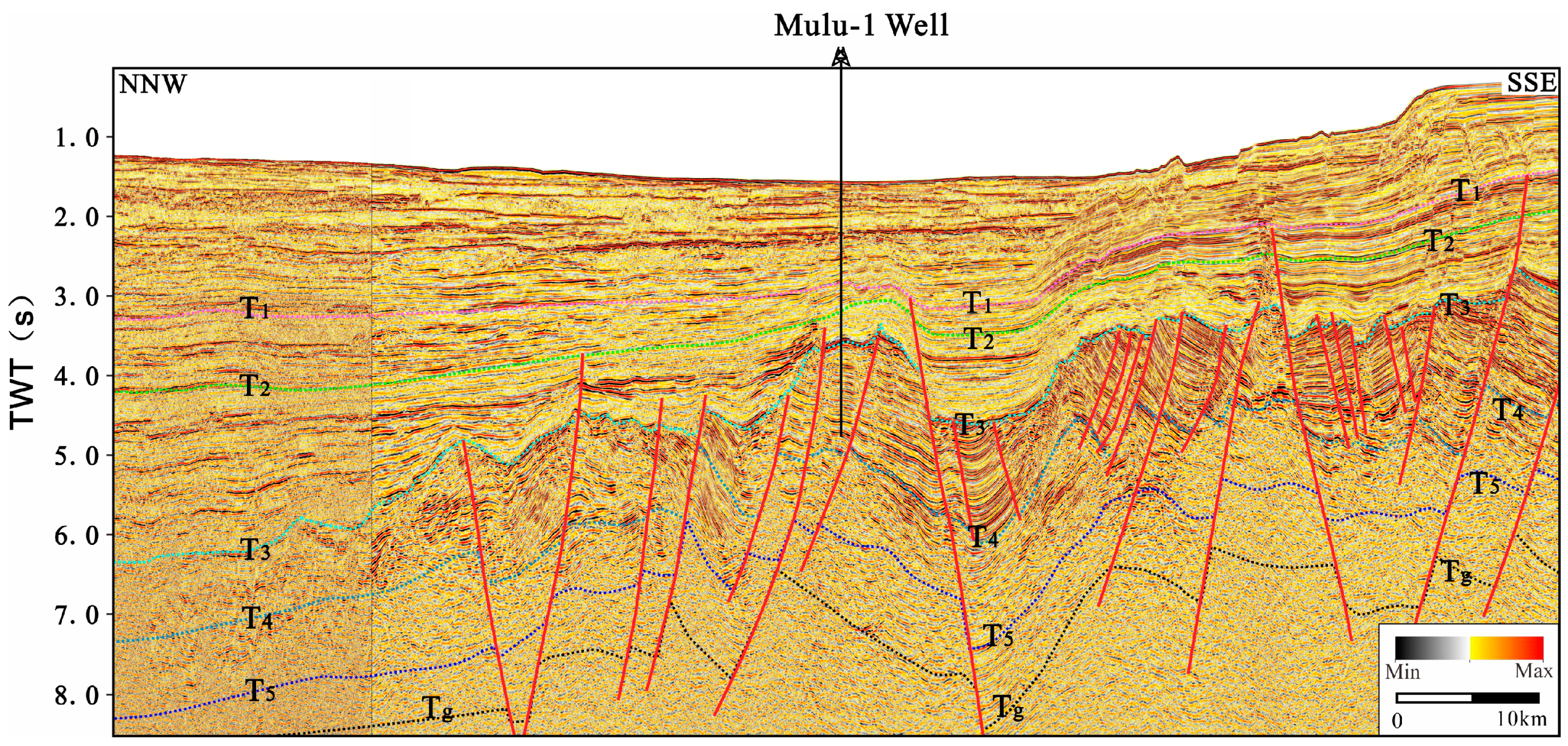
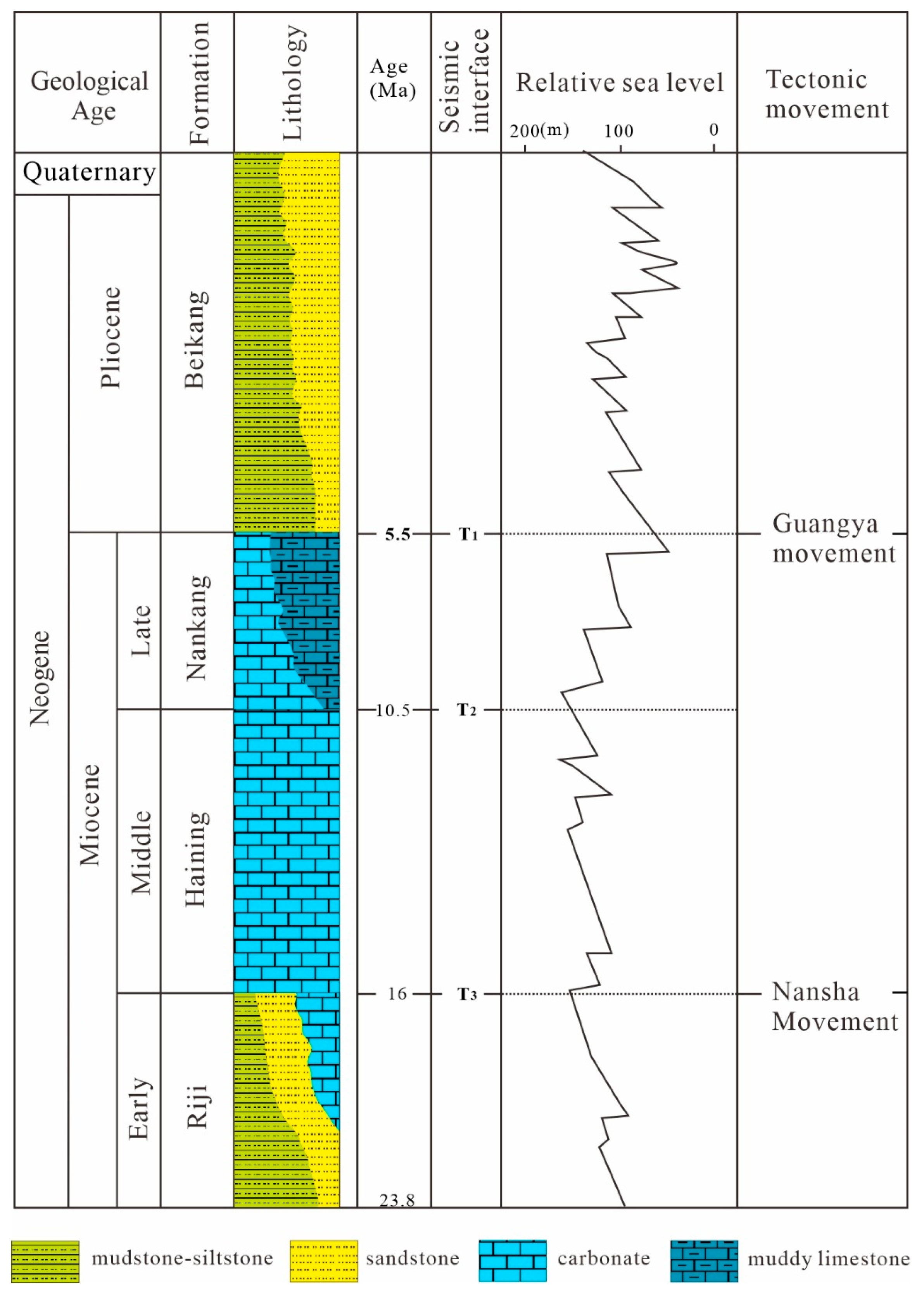
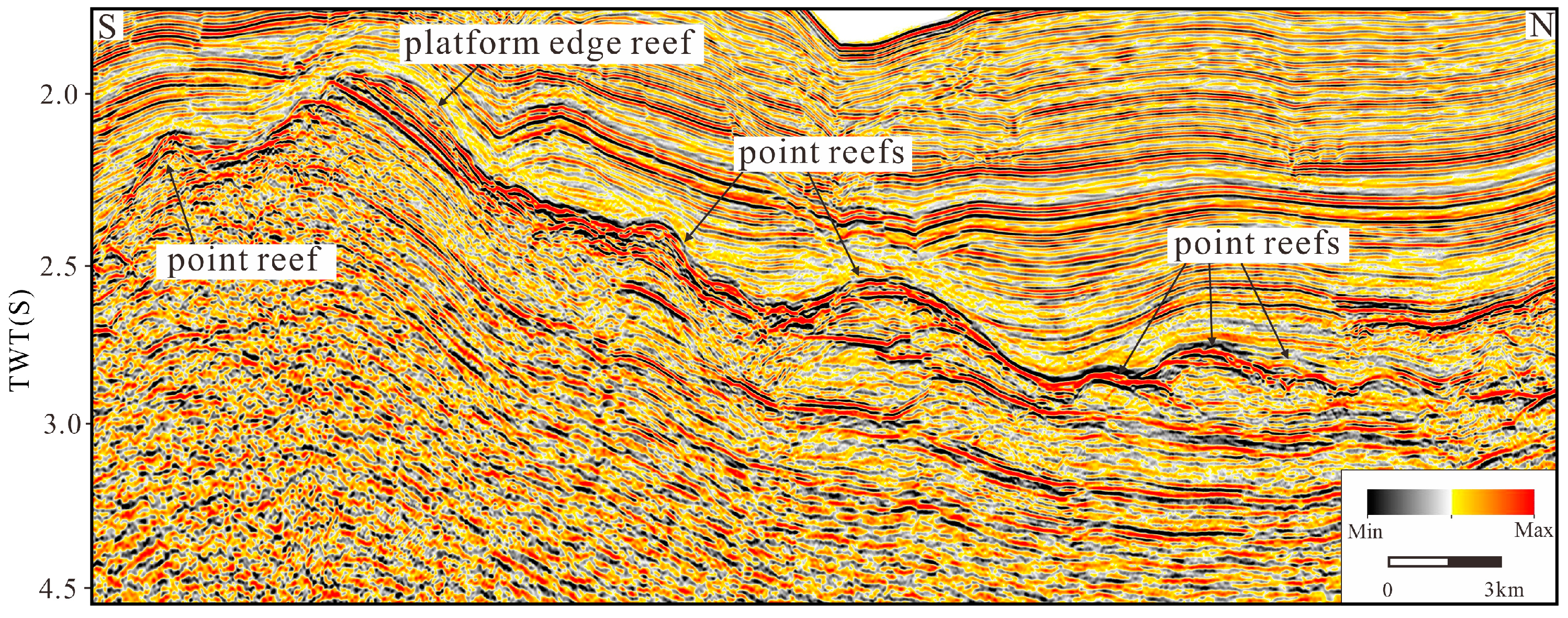
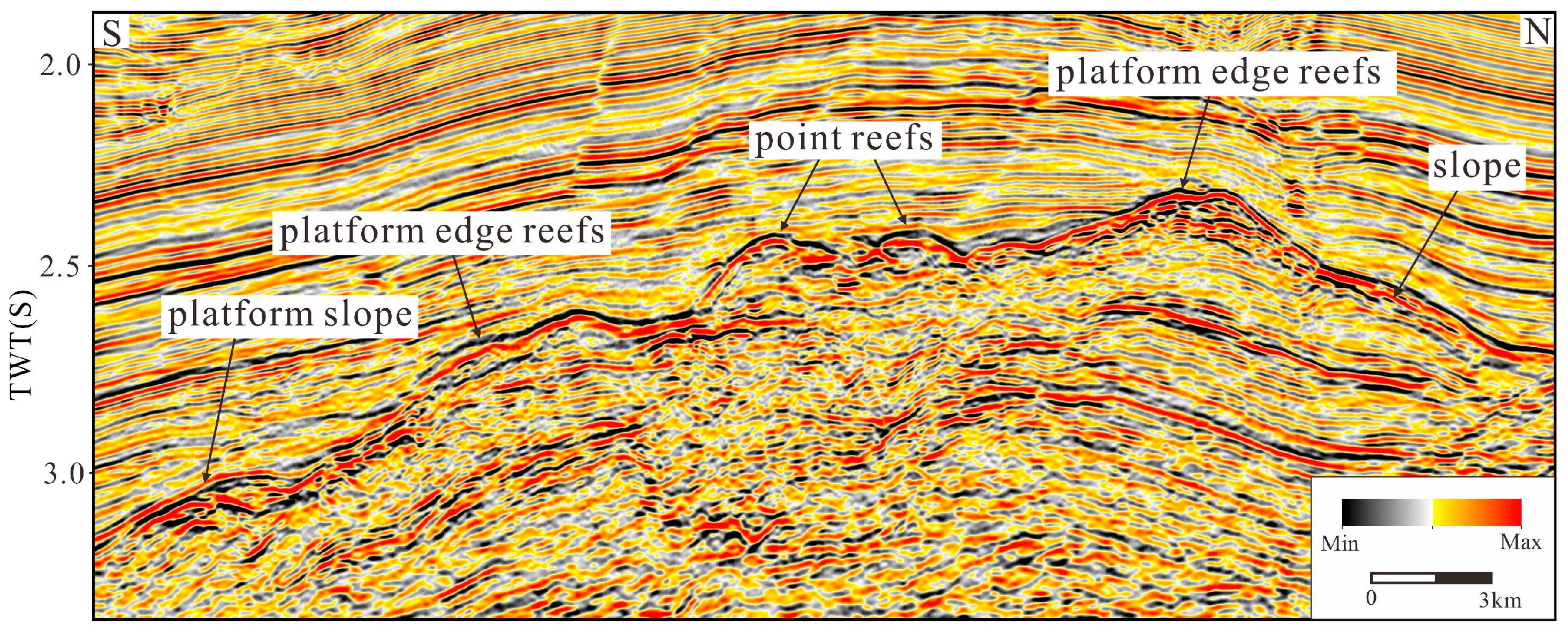
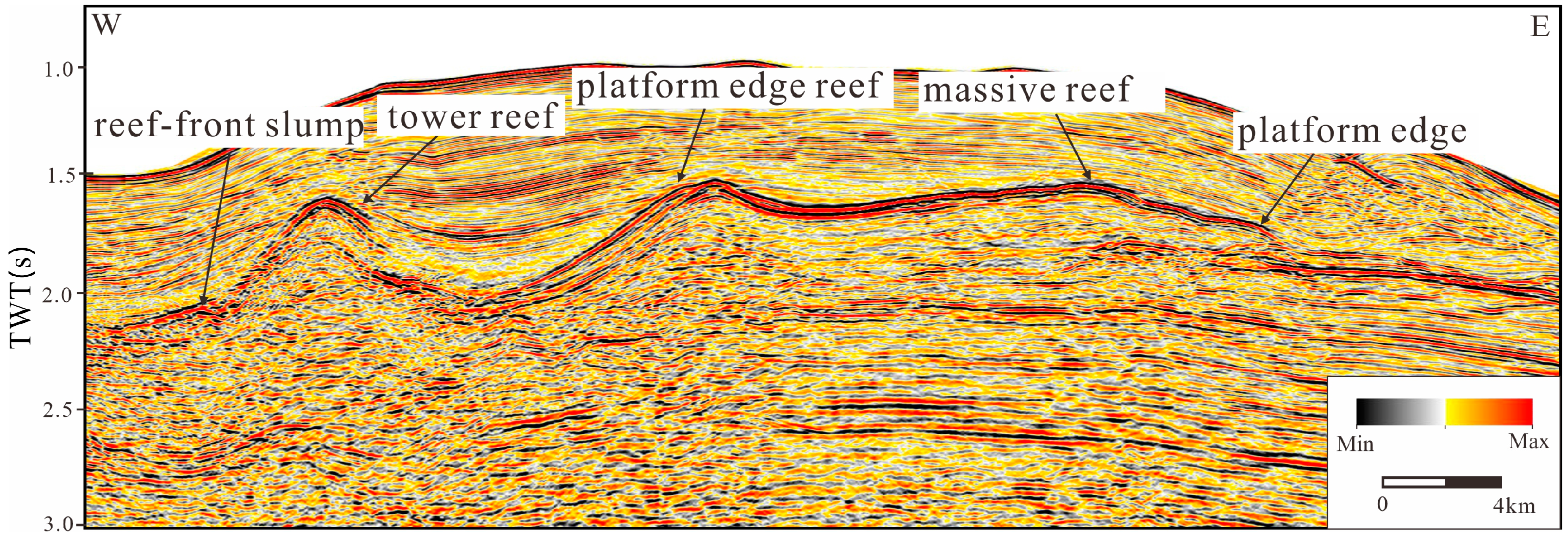



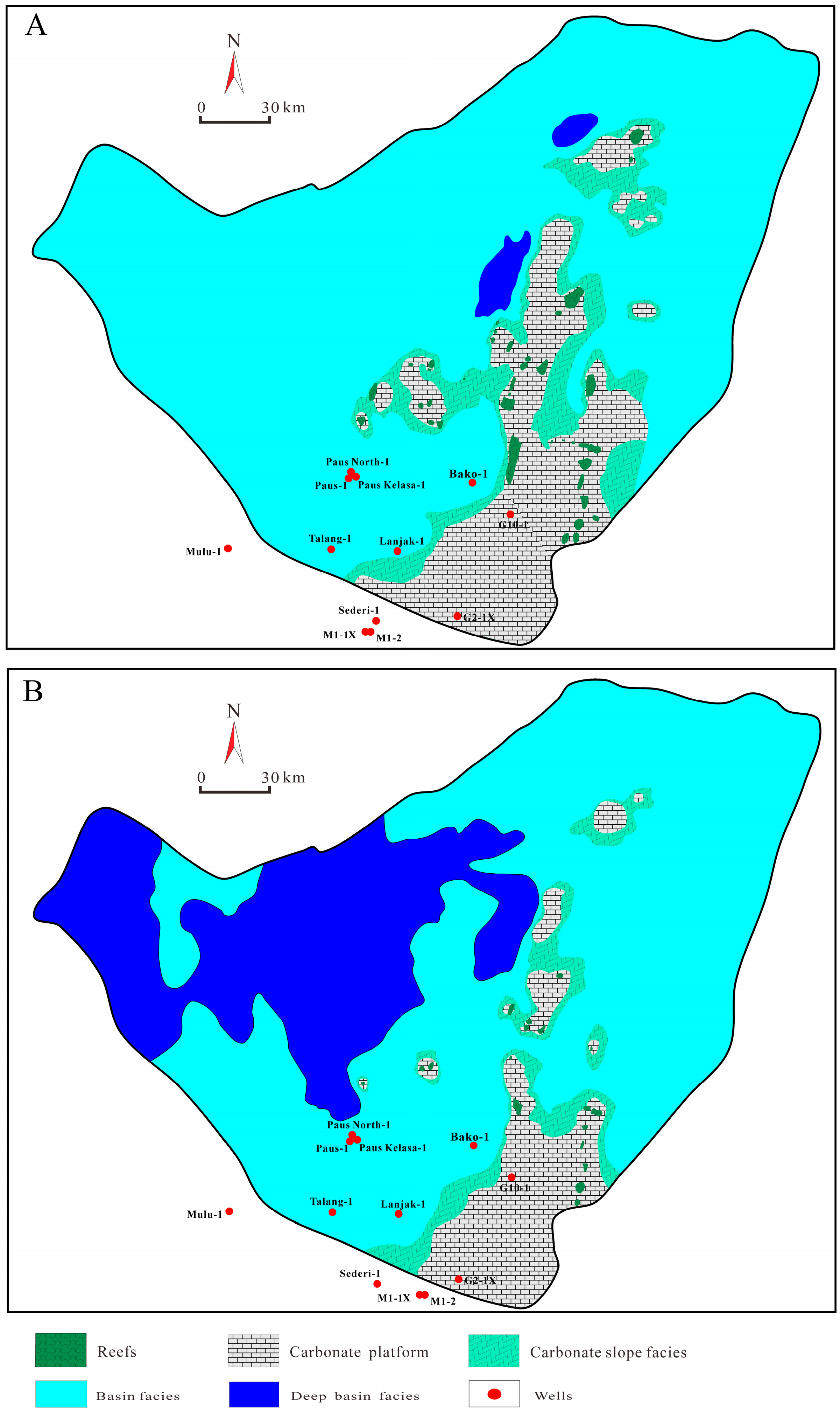
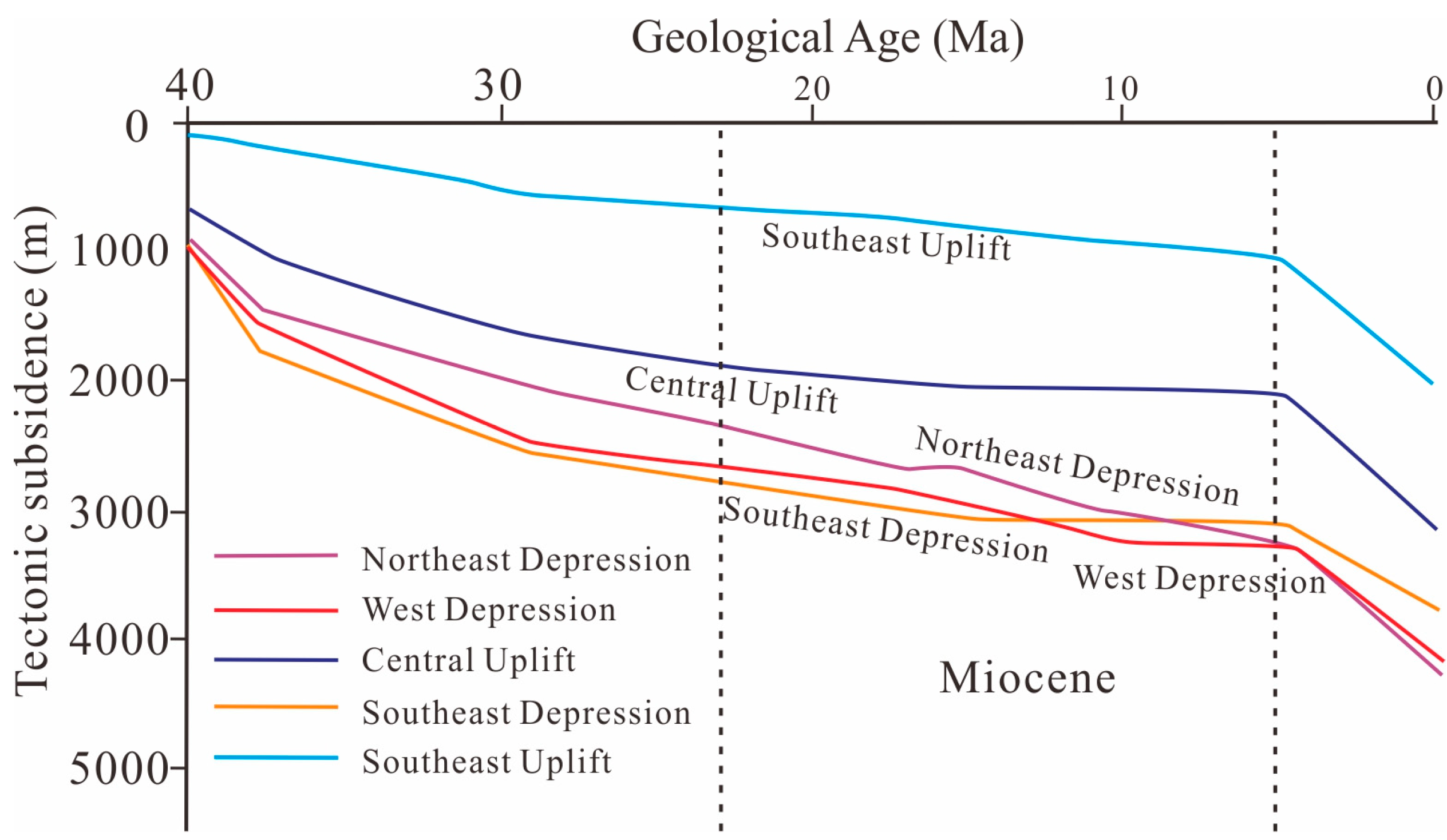
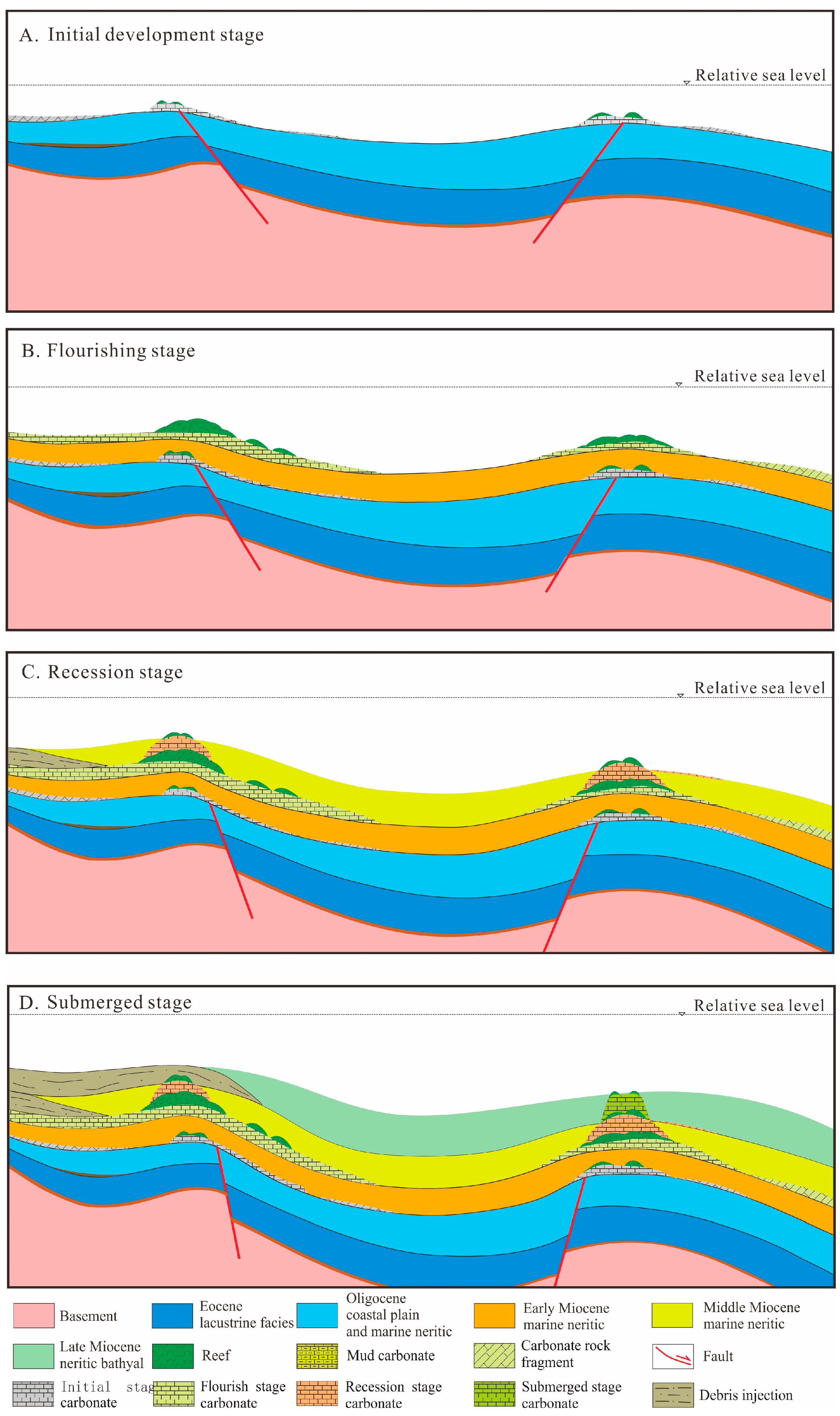
Disclaimer/Publisher’s Note: The statements, opinions and data contained in all publications are solely those of the individual author(s) and contributor(s) and not of MDPI and/or the editor(s). MDPI and/or the editor(s) disclaim responsibility for any injury to people or property resulting from any ideas, methods, instructions or products referred to in the content. |
© 2024 by the authors. Licensee MDPI, Basel, Switzerland. This article is an open access article distributed under the terms and conditions of the Creative Commons Attribution (CC BY) license (https://creativecommons.org/licenses/by/4.0/).
Share and Cite
Yang, Z.; Fan, G.; Yan, W.; Wang, X.; Zhang, G.; Yang, Z.; Zhu, Z.; Zhang, Y.; Cheng, H.; Tian, H.; et al. Types and Evolution of the Miocene Reefs Based on Seismic Data in the Beikang Basin, South China Sea. J. Mar. Sci. Eng. 2024, 12, 360. https://doi.org/10.3390/jmse12020360
Yang Z, Fan G, Yan W, Wang X, Zhang G, Yang Z, Zhu Z, Zhang Y, Cheng H, Tian H, et al. Types and Evolution of the Miocene Reefs Based on Seismic Data in the Beikang Basin, South China Sea. Journal of Marine Science and Engineering. 2024; 12(2):360. https://doi.org/10.3390/jmse12020360
Chicago/Turabian StyleYang, Zhen, Guozhang Fan, Wei Yan, Xuefeng Wang, Guoqing Zhang, Zhili Yang, Zuofei Zhu, Yuanze Zhang, Huai Cheng, Hongxun Tian, and et al. 2024. "Types and Evolution of the Miocene Reefs Based on Seismic Data in the Beikang Basin, South China Sea" Journal of Marine Science and Engineering 12, no. 2: 360. https://doi.org/10.3390/jmse12020360
APA StyleYang, Z., Fan, G., Yan, W., Wang, X., Zhang, G., Yang, Z., Zhu, Z., Zhang, Y., Cheng, H., Tian, H., Li, L., & Zhang, Q. (2024). Types and Evolution of the Miocene Reefs Based on Seismic Data in the Beikang Basin, South China Sea. Journal of Marine Science and Engineering, 12(2), 360. https://doi.org/10.3390/jmse12020360





